In the Moment:
Michael Frye's Landscape Photography Blog
by Michael Frye | Mar 20, 2016 | Advanced Techniques
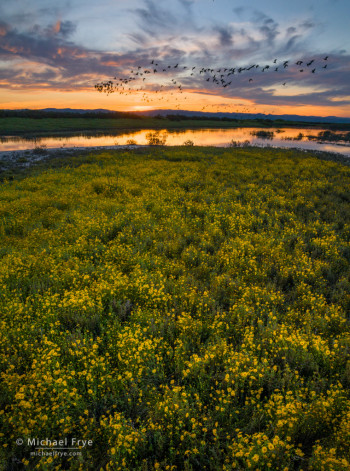
White-faced ibises, goldfields, and a vernal pool at sunset, San Joaquin Valley, Calfornia
There’s often an element of luck in landscape photography. Of course, as Ansel Adams said, “Chance favors the prepared mind.” You have to try to put yourself in the right place at the right time, and then make the most of the opportunities you get. But sometimes luck goes above and beyond.
Yesterday Claudia and I made a day trip to the Bay Area on business, and on our way home we decided to check out some vernal pools in the San Joaquin Valley. Vernal pools fill with water during the winter rainy season, and then slowly evaporate during the spring. As they evaporate, flowers grow along their shores, sometimes forming concentric rings of color. As California’s Central Valley got plowed and paved over, vernal pools became increasingly scarce, so they’re home to several rare species of plants and animals. Most of the remaining vernal pools can be found along the edges of the valley, where the land rises slightly, but the San Luis National Wildlife Refuge complex and Great Valley Grasslands State Park have preserved some vernal pools in the heart of the San Joaquin Valley, and that’s where we headed.
(more…)
by Michael Frye | Feb 8, 2016 | Vision and Creativity
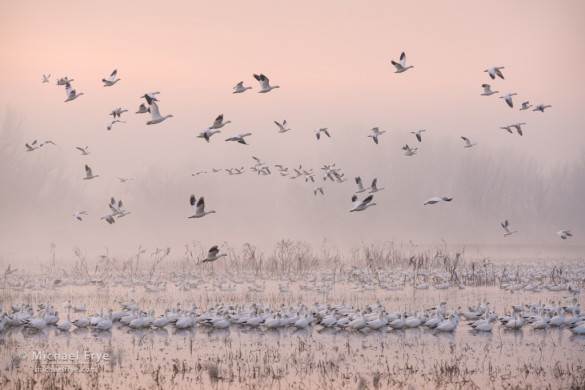
Ross’s geese in the fog at sunrise, San Joaquin Valley, CA, USA
Claudia and I have made several trips to California’s Central Valley this winter to photograph birds. It’s one of our favorite things to do this time of year, when large flocks of waterfowl take up residence in the valley’s marshes for a few months before migrating northward in the spring. I love watching and photographing the movements of these flocks, especially the white geese – the snow geese and Ross’s geese. Seeing 10,000 geese take off in a single, noisy, coordinated wave is simply awe-inspiring, but there’s magic and beauty in their smaller comings and goings as well.
My approach to photographing wildlife is similar to my approach to photographing landscapes. Rather than making closeup photographs of individual animals, I’m trying to incorporate the animals into the landscape, looking for ways to capture a mood and convey what it felt like to be in a particular place at a particular time, watching a unique and beautiful moment.
(more…)
by Michael Frye | Dec 31, 2015 | Announcements
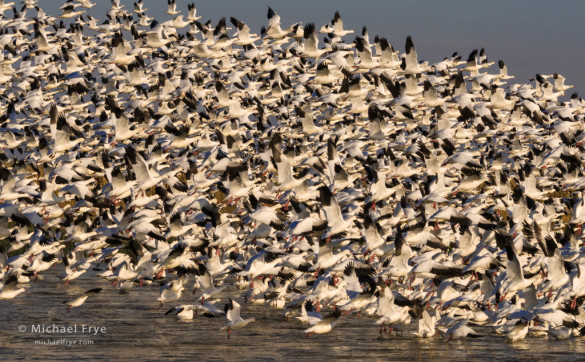
Ross’s geese lifting off from a San Joaquin Valley marsh, CA, USA
Happy New Year everyone! May all your dreams take flight in 2016.
Tomorrow I’ll be posting the nominees for my best photos of 2015, and you’ll get a chance to vote for your favorites and help me pick the top ten. Keep an eye out for the post! You can see last year’s nominees here, and the winners here.
Here are a few images from a recent trip to the San Joaquin Valley. Every year millions of migrating birds make their way to California’s Central Valley to spend the winter. Watching and listening to these massive flocks as they land and take flight is one of our favorite things to do, so Claudia and I try to get down there every chance we get over the brief winter season. We’ve only managed one bird-photography day so far this winter, but it was a good one, as we got to witness several mass goose takeoffs in beautiful light.
(more…)
by Michael Frye | Feb 22, 2015 | Yosemite Photo Conditions
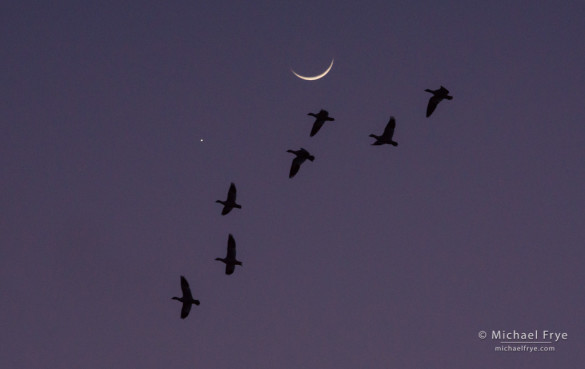
Moon, Venus, and Ross’s geese, San Joaquin Valley, CA, USA
I’ve been working on a book deadline, so haven’t been able to get to Yosemite Valley and check on Horsetail Fall recently. But I did break away from the desk on Friday to go down to the Central Valley and photograph birds. At first the light was rather uninspiring, because the fog I was hoping for had lifted into a low overcast. But it turned out to be a great day. I photographed one of the biggest goose takeoffs I’ve ever seen, with perhaps 30,000 birds lifting off at once; one of the photographs below shows part of that group. Later, the sun broke through the stratus deck to create some beautiful sunbeams, and at dusk Venus and the crescent moon appeared (above).
As for Horsetail, the flow diminished quickly after the last rainstorm, and from reports I’ve heard there is basically no water in it – just a bit of dampness. There is another storm predicted for today and tomorrow. This is expected to be both colder and weaker than the last storm, with snow levels around 6,000 feet, but limited moisture. Horsetail might get some help from this system, but probably not much. Even if this storm turns out to be bigger than predicted, any precipitation in Horsetail’s drainage will fall as snow, so there won’t be a significant boost in flow until the sun comes out and melts some of that snow. It’s supposed to be sunny Tuesday, Wednesday, and Thursday, so maybe by Wednesday or Thursday we could see a decent water flow in Horsetail.
(more…)
by Michael Frye | Feb 15, 2015 | Composition, Light and Weather
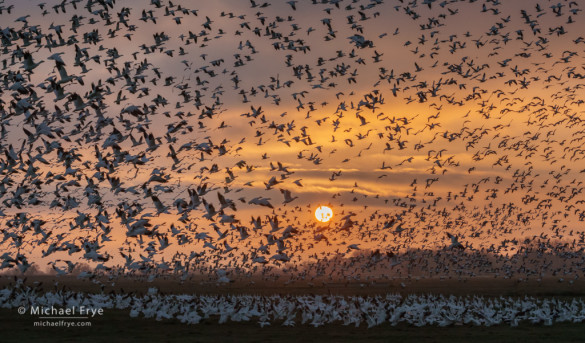
Ross’s geese taking flight at sunset, San Joaquin Valley, CA, USA
It should come as no surprise to any photographer that the interaction between subject and light is important. In fact, I’d say that this interaction is the essence of the whole thing; it’s what photography is all about.
But which comes first? Do you look for an interesting subject, and then find the right light for it? Or do you look at the light first, and then find a subject that fits the light?
I think both approaches can work. But having said that, I almost always think about light first. What’s the light now? What might happen to the light in the next five minutes, ten minutes, hour, or two hours? I try to anticipate how the light and weather might change, decide what kind of subject(s) could work with that light, and only then decide where to go.
(more…)













